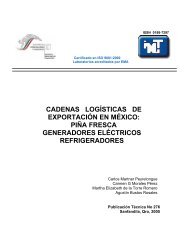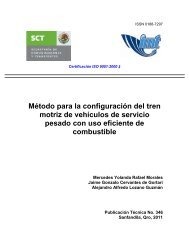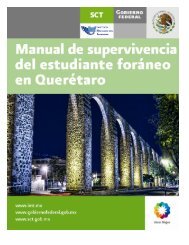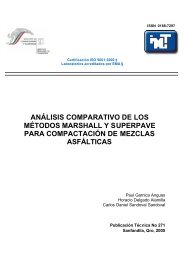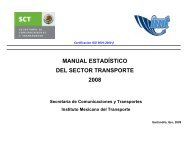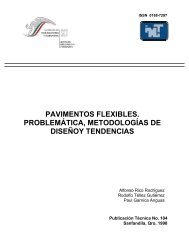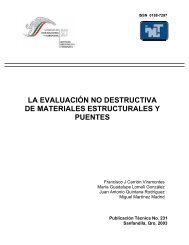introducción a la mecánica de suelos no saturados en vías terrestres
introducción a la mecánica de suelos no saturados en vías terrestres
introducción a la mecánica de suelos no saturados en vías terrestres
You also want an ePaper? Increase the reach of your titles
YUMPU automatically turns print PDFs into web optimized ePapers that Google loves.
D<strong>en</strong>sidad seca, ρ d ( g/cm 3 )<br />
1.90<br />
1.85<br />
1.80<br />
1.75<br />
1.70<br />
1.65<br />
1.60<br />
1.55<br />
1.50<br />
1.45<br />
1.40<br />
1.35<br />
1.30<br />
Sr=20 %<br />
Sr=30 %<br />
Sr=40 %<br />
ψ=4.0 MPa<br />
3.0 MPa<br />
2.0 MPa<br />
Sr=50 %<br />
Sr=60 %<br />
1.0 MPa<br />
Capítulo 3 Mecánica <strong>de</strong> <strong>suelos</strong> <strong>en</strong> ing<strong>en</strong>iería <strong>de</strong> pavim<strong>en</strong>tos<br />
Sr=70 %<br />
Sr=80 %<br />
ψ=0.7 MPa<br />
4 6 8 10 12 14 16 18 20 22 24<br />
Sr=90 %<br />
ψ=0.5 MPa<br />
Cont<strong>en</strong>ido <strong>de</strong> agua, w (%)<br />
Sr=100 %<br />
0.2 MPa<br />
Esfuerzo neto isótropo, (σm-ua)<br />
0.1 MPa<br />
T<strong>en</strong>siones netas isótropas, (σm-ua )<br />
0.3 MPa<br />
0.6 MPa<br />
1.2 MPa<br />
Figura 3.6 Curvas <strong>de</strong> compactación para tres esfuerzos isótropos y contor<strong>no</strong>s <strong>de</strong> igual succión (y)<br />
total <strong>de</strong>spués <strong>de</strong> <strong>la</strong> compactación, para una arcil<strong>la</strong> <strong>de</strong> baja p<strong>la</strong>sticidad <strong>de</strong> <strong>la</strong> ciudad <strong>de</strong> Barcelona<br />
(Barrera, 2002).<br />
La Fig. 3.7 reproduce <strong>la</strong> succión matricial medida mediante <strong>la</strong> técnica <strong>de</strong>l papel <strong>de</strong> filtro <strong>en</strong> mezc<strong>la</strong>s <strong>de</strong><br />
arcil<strong>la</strong> <strong>de</strong> Londres y ar<strong>en</strong>a bajo difer<strong>en</strong>tes humeda<strong>de</strong>s. La <strong>en</strong>ergía <strong>de</strong> compactación está próxima al<br />
Proctor modificado. En <strong>la</strong> figura se han indicado <strong>la</strong>s condiciones correspondi<strong>en</strong>tes a <strong>la</strong> humedad<br />
óptima. Se pue<strong>de</strong> apreciar que cambios pequeños <strong>de</strong> humedad produc<strong>en</strong> variaciones importantes <strong>en</strong> <strong>la</strong><br />
succión inicial. Los datos <strong>de</strong> Marinho y Chandler (1993) con los publicados por Acar y Nyeretse<br />
(1992) correspon<strong>de</strong>n a mezc<strong>la</strong>s <strong>de</strong> montmorillonita, caolinita y ar<strong>en</strong>a fina compactadas <strong>en</strong> el aparato<br />
miniatura <strong>de</strong> Harvard. En este caso <strong>la</strong> succión se midió mediante psicrómetros y por tanto correspon<strong>de</strong><br />
a succión total. A pesar <strong>de</strong> <strong>la</strong>s difer<strong>en</strong>cias <strong>en</strong> método y <strong>en</strong>ergía <strong>de</strong> compactación y <strong>de</strong>l hecho <strong>de</strong><br />
81



